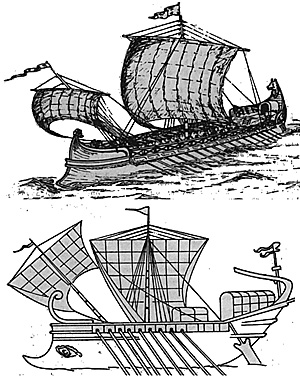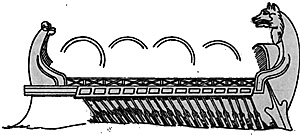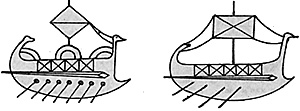 The following verbatum quote from the Notes on the Ships of Antiquity in the end papers of
"The Cruise of the Dolphin" by Ferdinand Lallemond (Methuen 1957) may be of help.
The following verbatum quote from the Notes on the Ships of Antiquity in the end papers of
"The Cruise of the Dolphin" by Ferdinand Lallemond (Methuen 1957) may be of help.
Naval Acturias (from a mosaic in Sousse Museum, Tunisia) on which the rigging of the design was based. A photo of this mosaic appears on page 110 in the book "A Naval Acturias (from a mosaic in Sousse Museum, Tunisia) in which the rigging of the design was based. A photo of this mosaic appears on page 110 in the book "A History of Warfare" by Field-Marshal Montgomery.
"Between the round ships and the long ships must be placed the acturias; this was a cargo ship used by the fleet with sails and one bank of oars. It carried an immense beak, anapulustre instead of a chaniscos, and was used as a troop transport or as a supply ship."
This authority seems to limit the use more to Naval operations than general use which seems to be suggested by sketches C and D. It is all guesswork when you go back this far!
The plan for the Acturias is based on a stone relief found in the Moselle Valley although other French sources connect the ship with Southern France. The relief is unrigged but Roman mosaics show similar ships rigged. This vessel is a cross between the Roman Round ship and war galley and ships of her type can be found with the traditional goose head ends of Roman merchant men and the Roman Naval Apulustre. (You may read in some books that the goose head decoation is a Roman original and comes from the story of geese warning Rome of attack. Both the goose head decoration and the apulustre are found on Phonetian vessels and the apulustre may have originated in the Minoan Cretian ships).
The Acturias has its origins in the very early merchant shipsl and would have been used to carry any form of cargo. They had advantages over the round ship when being used on the edges of the Empire and for river and coastal trade in that they were not reliant on wind. Their carrying capacity made them useful troop transport and supply vessels and my calculations suggest that these vessels had a far greater range of operations than those that can be obtained from pure naval vessels. The bow on this vessel is not a ram, but a, cutwater-bow whose sole use was to increase the length of waterline and thus reduce the resistance of the vessel. It is possible that this bow could have been strengthened on naval and private vessels and used for ramming. Later ship. designs of the Roman Empire suggest that as well as the more traditional warships there were also triremes and biremes which had features of the Acturias.
 Sketch of a bas-relief (from Musee de Saint-Germainen-Large) on which the design was mainly based.
Sketch of a bas-relief (from Musee de Saint-Germainen-Large) on which the design was mainly based.
The oars on these vessels come through the hull at main deck level or just below deck and the upper bank of oars are lashed to the rails (See Landstrom "Sailing Ships'! page 49, fig. 111).
When working on my designs it became obvious that this type of warship would not have been suitable in the later Empire in cases where Naval stations had been established and regular naval patrols were conducted to safeguard the Empire against pirates and Barbarians.
One finds that pirates were always a menace in the Mediterranean. King Minos of Crete is noted for clearing the Sea of Pirates and they keep cropping up throughout Ancient and Middle age history. In fact a recent book by Prof. Alberto Tenenti of the University Of Pisa states that piracy was a significant factor in the decline of Venice 1580-1615 AD.
In earlier Naval Histories it has been stated that Rome was not a sea power, but it has been pointed out, and a fuller analysis made in the more modern-Naval Histories, that if Rome had not been or become a Naval power, the Empire would not have existed. To control the Mediterranean she had to control the sea against the City States of Greece and the most powerful and rival Carthaginian Empire who had inherited the Phoenetian trade monopolies.
In the North the Veneti had to be cleared from the Channel in 56BC before Julius Caesar could land in Britain. The Roman history of Britain alone, an outpost of Empire, shows that the island had to be constantly protected from attack by sea. This must also have been true for other continental territories. With the fall of the Roman Empire the vandals were free to sail the Western Mediterranean and in 455 AD were able to anchor unopposed in the mouth of the Tiber.
Roman Naval power definitely fluctuated throughout the period, and Naval strength depended upon the whims of the Senate who would only vote money for Naval construction in time of need. A Navy of sorts must have existed for Rom to control the islands and coasts of the Mediterranean. Sea transport would have been the fastest means of communication throughout the Empire. With regard to ship speeds Thucydides records a Greek galley as capable of travelling 168 sea miles in 24 hours. Roman grain ships under sail alone are recorded as making the passage from Alexandinor to the Tiber in 5 days which seems to have been a regular passage time in good weather. A comparison of speed can also be gauged from the Ventian galley which was capable of 10 knots and the Spanish galleon which average 6 knots. The figures suggest that the probable average speeds for galleys were 7-8 knots and those for round ships were probably slightly less, the maximum speed being 9 knots with favourable winds and good weather.
 Similar vessals detailed in a mosaic at Low Ham Villa.
Similar vessals detailed in a mosaic at Low Ham Villa.
It is believed that the outer planking of these ships was first built together with the keel and then the frames added after, but the recent find at Blackfriars which is at present on view at the Science Museum, seems to have unnerved the experts as it dates from the 2nd century AD and is the frame with planks layed on recently was dated as first being used in the 15th Century AD.
My source for artillery is from the first section of "The Man of War" by Basil W. Bathe. He gives the date of artilleries first used as about 300 BC, but does not say who used it.
Nearing completion are plans for a 36 gun Frigate of 1790 based on the "Sirius" of Trafalgar fame. These are being drawn by another Naval Architect, Roger Freathy, who works with me.
The author of this article is a naval architect with Burness, Corlett and Partners one of the largest firms of Naval Architects and Marine Consultants in Great Britain. Commencing with plans for this ship Keith intends drawing similar plans for other warships of all periods. For the ACTURIAS, the General Arrangement costs 49p and the Lines Plan 38p from Springvale, 112A Roman Road, Basingstoke, Hants.
Back to Table of Contents -- Wargamer's Newsletter # 115
To Wargamer's Newsletter List of Issues
To MagWeb Master Magazine List
© Copyright 1971 by Donald Featherstone.
This article appears in MagWeb.com (Magazine Web) on the Internet World Wide Web.
Other articles from military history and related magazines are available at http://www.magweb.com